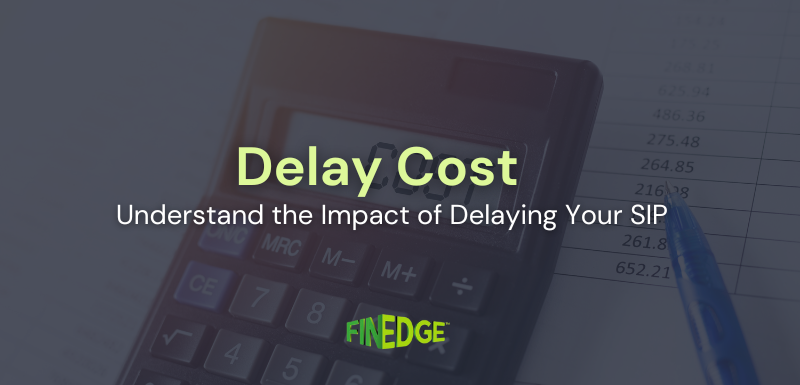How to Start SIP Investment: A Beginner-Friendly Guide for Long-Term Growth
- Understand what SIPs are and why they’re ideal for long-term investing.
- Learn how to start a SIP, step-by-step, including online setup.
- See how SIPs build wealth through rupee cost averaging and compounding.
If you're wondering how to start SIP investment, you're not alone. SIPs, or Systematic Investment Plans, have become one of the most popular tools for long-term wealth creation in India. They’re simple, disciplined, and powerful - especially for those earning monthly incomes and looking to grow their savings through mutual funds. This guide explains how SIPs work, how to get started (both online and offline), and why they are trusted by millions of investors for goal-based financial planning.
What is a SIP and How Does it Work?
A Systematic Investment Plan (SIP) allows you to invest a fixed amount at regular intervals, typically monthly, into a mutual fund scheme. This method automates your investments and encourages disciplined financial behavior.
Example
Meera sets up a SIP of Rs. 5,000/month in a diversified equity mutual fund. Every month, that amount gets automatically debited from her account and invested into the fund. Over time, she accumulates more units, more when markets are low, fewer when markets are high, helping her average out her purchase cost.
Features of SIPs That Make Them Ideal for Investors
-
Low minimum investment: SIPs can be started with as little as Rs. 100 per month.
-
Flexibility: You can increase, pause, or stop SIPs whenever you need to.
-
Rupee cost averaging: Investing across market cycles helps average out your cost per unit.
-
Power of compounding: Small amounts invested over long durations can snowball into significant wealth.
-
Step-up option: You can automatically increase your SIP amount annually as your income grows.
Pro Tip
Starting early and staying consistent are the two golden rules of SIP investing.
How to Start an SIP Investment: Step-by-Step
1. Define Your Financial Goal
Whether it’s your child’s education, your retirement, or buying a house; have clarity on what you’re investing for.
2. Choose the Right Mutual Fund Scheme
This depends on your time horizon and risk appetite. Equity funds work well for long-term goals, while hybrid or debt funds are better for short-term needs.
3. Decide the Monthly SIP Amount
Use a SIP calculator to estimate how much you need to invest to meet your goal.
4. Complete Your KYC
You’ll need to complete KYC (Know Your Customer) with PAN, Aadhaar, and address proof. Most platforms let you do this digitally.
5. Set Up Auto-Debit Mandate
Link your bank account and allow auto-debit for the SIP amount on a specified date each month.
6. Track and Review Annually
Stay the course, but review your SIPs once a year to see if they’re aligned with your goals.
How to Start an SIP Online
Most Asset Management Companies (AMCs) and investment platforms make it easy to set up SIPs online. Here’s how:
-
Visit the AMC website or a trusted intermediary platform.
-
Register or log in with your credentials.
-
Choose the mutual fund scheme and opt for SIP instead of lumpsum.
-
Enter SIP details: amount, frequency, start date, and end date.
-
Set up a one-time e-mandate to authorize automatic debit.
-
Confirm your investment and receive a confirmation on email/SMS.
Make sure your account has sufficient balance at least 1–2 days before SIP debit date to avoid rejections.
Why SIPs are Better Than Lumpsum Investments for Most People
While lumpsum investing has its place, SIPs offer these advantages:
-
Lower risk: You avoid investing all your money at a market high.
-
Budget-friendly: Matches your monthly cash flow.
-
Behavioral edge: Reduces temptation to time the market.
Long-term data shows that SIPs deliver strong outcomes even through volatile markets.
Real-World SIP Growth Example
Let’s take a case of someone investing Rs. 10,000/month through SIP in a well-performing mutual fund:
-
Duration: 25 years
-
Total invested: Rs. 30 lakhs
-
Corpus grown: ~Rs. 2 Crores at ~13% CAGR
This period includes major market events like the Dot Com crash, Global Financial Crisis, and COVID-19. Despite ups and downs, SIPs rewarded patience and discipline.
Things to Keep in Mind Before Starting Your SIP
-
Don’t stop SIPs during market dips; that’s when they’re most powerful.
-
Link SIPs to specific financial goals.
-
Avoid starting SIPs in unsuitable products like ULIPs or traditional insurance plans.
-
Reassess your SIPs if your goals, income, or risk appetite changes.
FAQs
Your Investing Experts
Continue Reading
Cost of Delay in Investment: Why Starting Early Matters
Many investors assume that postponing their SIP temporarily has a minor impact. In reality, the true loss comes from the compounding opportunity that disappears with every missed month. A consistent approach is far more powerful than trying to compensate later by investing larger amounts.
How to Cancel Your SIP Online: A Step-by-Step Guide
Stopping a Systematic Investment Plan (SIP) is simple but following the right steps ensures your cancellation request is processed smoothly without delays.
How to Build a ₹1 Crore Portfolio: A Practical Guide for Indian Investors
Reaching ₹1 crore isn’t about luck or timing, it’s about discipline, consistency, and the patience to let compounding work in your favor.
.png)

.png)
